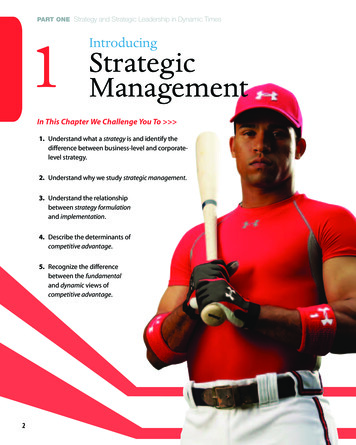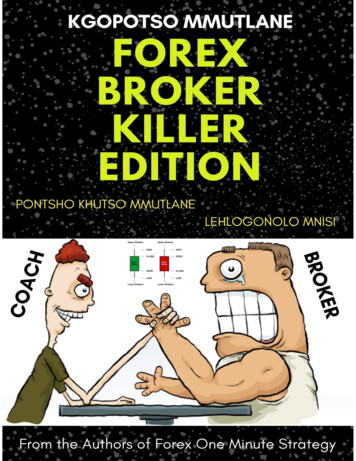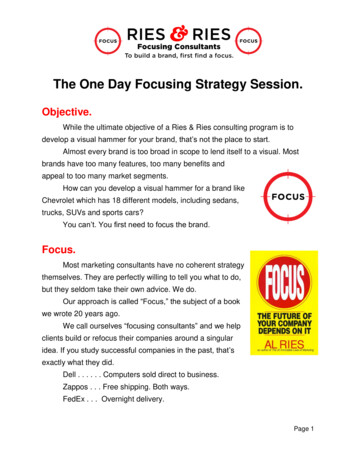
Transcription
PART ONE Strategy and Strategic Leadership in Dynamic Times1IntroducingStrategicManagementIn This Chapter We Challenge You To 1. Understand what a strategy is and identify thedifference between business-level and corporatelevel strategy.2. Understand why we study strategic management.3. Understand the relationshipbetween strategy formulationand implementation.4. Describe the determinants ofcompetitive advantage.5. Recognize the differencebetween the fundamentaland dynamic views ofcompetitive advantage.2
Click Clack—David ChallengingGoliathTwelve years ago, Kevin Plank was a walk-onfootball player for the University of Maryland Terrapins.He hated how his cotton T-shirts became soaking wet withsweat during every practice.The wet T-shirts would causechaffing, gain several pounds in weight, and generally just feelvery uncomfortable. He wondered why, in an era of microfiberfabric with moisture-wicking properties, he and other football playershad to put up with uncomfortable cotton T-shirts under their shoulder pads. Runners,bicyclists, and others were already benefiting from clothing made of advanced materials tomake their workouts more comfortable. Plank, who grew up always looking for a way to makemoney, went to a fabric store and bought a bolt of moisture-wicking fabric and paid3
4PART ONE Strategy and Strategic Leadership in Dynamic Timesa tailor to make several prototype shirts.Plank’s teammates envied his new shirts,so he set out to make more samples.He officially launched his company out of hisgrandmother’s basement and called his product Under Armour . As you can seefrom the snapshot in Exhibit 1.1, sales in 2006 were 430 million, and the company’s equity was valued at over 1.8 billion.1 With such dominant incumbents asNike and adidas,how did Plank successfully enter and grow his company into oneof the best performing companies on Wall Street? Apparently, at least early on, itscompetitors did not heed Under Armour’s savvy and mega-successful advertisingcampaign titled“Click-Clack:I think you hear us coming!”Although Under Armourhas been successful to date, surely Nike and others did not stand idly by whilewatching its customers migrate to the new upstart.What can Under Armour do tomaintain and grow its position in the industry? Let’s first look at the industry,thenwe’ll review Under Armour’s strategy for entering and competing in this dynamicindustry.Exhibit 1.1Under Armour at a Glance1996Revenues 17,0002006 430,000,000Net Income057,300,000Equity Value01,800,000,000Revenue Distribution3.5%3.6%6.2%7.4%Apparel19.9%men’s 59.4%women’s 19.9%youth 7.4%59.4%footwear 6.2%accessories 3.5%licensing revenues 3.6%Brands and TrademarksUnder Armour , HeatGear , ColdGear ,AllSeasonGear , LooseGear , Under Armourdesign mark, Protect This House , Duplicity ,I Think You Hear Us Coming and Click Clack NYSE Ticker(Went public in August2005)UAKevin Plank’s VisionTo become the #1 performance athletic brand in the world
C h a p t e r 1 Introducing Strategic ManagementThe Performance Apparel Industry Under Armour participates in the sports apparelmarket, which NPD Group, a leading provider of consumer and retail market research information, estimated was a 45 billion market in 2006. Approximately 30 percent of themarket is synthetic product and purchased for use in active sport or exercise.While onemight assume that Nike dominates the market, in fact the active sports apparel marketis fragmented—10 brands combine to comprise the top 30 percent of the market.Historically, exercise clothing consisted of products made with relatively unsophisticated design and generic fabrics. The most common shirt used in exercise was a standard cotton T-shirt, often decorated with logos and company or team names. Insegments like running and basketball, there were specialized jerseys made of synthetic fibers and tank top designs that improved performance. Lycra revolutionizedsportswear in the late twentieth century, and the microfibers revolutionized the market later.Fabrics like fleece and Sympatex were specifically developed for fluctuationsin weather conditions. It is unlikely that street fashion would have adopted them soreadily if there had not been the status association of sporting prowess.When this wascombined with effective functional utility, a fabric fashion was born that encompassedall ages from young skateboarders to mature golfers. Moisture-management fiberswere developed to accommodate the desire for more comfortable sportswear. According to Dupont, who invented Coolmax and Tactel , function is paramount.Thesefibers are used commonly today not only in sports apparel, but in other products ranging from socks to lingerie.The performance apparel segment of the sports apparel market is growing more rapidlythan other segments. This growth is fueled by demographic trends and increased consumer awareness and participation in active lifestyles.During the past two decades,consumers have continued to spend heavily in the areas of weight loss and dieting, fitnesscenter memberships, and sports and athletic equipment. And sports enthusiasts tend tospend more for their equipment than casual users, which translates to the possibility forhigher price points and greater margins.As upstarts like Under Armour in sports apparel and Sketchers in specialized footwearhave gained strong footholds in emerging segments, industry giants like Nike and adidas have taken notice and responded in kind with their own specialized products. However, while the market is large and growing rapidly, incumbents in traditional segmentsof the industry have not grown as rapidly.Under Armour’s Entry The original Under Armour shirt that Kevin Plank designed wasmade as a form-fitting compression using microfiber that would wick perspiration awayfrom the body and dry quickly.The shirts he shared with teammates were a big hit and thisled him to believe there was a market for these “performance shirts.” He guessed therewould be a big market for his shirts among professional and amateur athletes who, likehimself, were irritated by working out in cotton shirts but continued to do so simply because there were few alternatives. Kevin Plank figured he had a winning product that wasquite different from current products.His product has three distinct features.First, the fabric wicks moisture and dries quickly (a sweat-soaked cotton T-shirt can weigh two to threepounds). Second, Plank used a compression design—tight, form-fitting cuts that reducedthe amount of fabric and improved comfort when worn under a uniform (and equipmentlike shoulder pads).Third, Under Armour shirts were made with a tagless design; conventional tags on the collar often irritate the neck of athletes.Plank designed a way to heat-sealthe tag information directly to the fabric rather than needing to sew on a separate tag.With a superior product designed for a specific market, Plank still faced the issue ofhow to get his product to market. Like many entrepreneurs, he started with who he5
6PART ONE Strategy and Strategic Leadership in Dynamic Timesknew—former teammates from college and prep school who were now playing in theNFL. He figured that if he could get some professional athletes to use the product,teammates would hound them for their own shirts, much like his college teammatesdid at Maryland. While working on getting athletes to demand his product, Plank alsowent about securing wholesale and retail accounts. Early NFL players who startedwearing Under Armour shirts included quarterbacks Jeff George and Frank Wycheck(a former Maryland teammate) and all pro and hall of fame receiver Jerry Rice. In baseball, Roger Clemens got Under Armour rolling by being an early adopter of the newshirts. Today, Under Armour is available via the Internet, catalogs, and 12,000 sportinggoods stores worldwide.With the early success of the basic product, Under Armour set out to find natural product extensions.The first product growth came in expanding from the basic shirt, knownas AllSeason Gear , to HeatGear and ColdGear , products designed to be worn in hotclimates or cold temperatures while still providing the basic performance technology ofthe original product. Later, Under Armour looked for additional growth from new geographic areas. The major targets for international expansion today are Europe and Asia.More recently, Under Armour has expanded into new product and sports segments. In2006, Under Armour launched what has proved to be a highly successful line offootwear. The specific target area? Football and baseball cleats. Why did Under Armourpick this particular segment? Plank says that the Under Armour strategy is not to be aniche player in football (or baseball) cleats. Rather, this segment is designed to be theplatform from which to launch into a broader athletic footwear position at a later time.Because so many football and baseball players were already using Under Armour performance shirts, Under Armour felt that they would be a very receptive audience forfootwear. The highly successful “Click-Clack” advertising campaign propelled Under Armour to a fabulous first year in footwear; in its first year of marketing cleats, Under Armour captured 20 percent market share overall, and an amazing 40 percent of themarket for cleats priced over 70! In 2007, Under Armour launched lines of performancesunglasses and sports watches, both targeted at the premium price segments.Under Armour’s targets for growth in the near future focus on three main areas. First,Plank plans to continue to reinvigorate the core products, which are men’s and women’sapparel. And, Under Armour is just beginning to grow in the women’s market.Within thebasic product segment, Under Armour sees room to expand into other sports. For instance, within the last year, Under Armour started to notice that their shirts were showing up on golf courses.Golfers who used the products in other activities saw the benefitsof the product while spending hours on the golf course.That led Under Armour to startmarketing a specific polo-style shirt line through golf stores and later to start a full lineof golf apparel. Similarly, Under Armour now targets outdoor adventure seekers(climbers, hikers, skiers), largely because they noticed the product being used in thosevenues. In addition, Under Armour sees lots of growth opportunity in footwear. Footballand baseball cleats are seen as a mechanism to get Under Armour into this vast and potentially lucrative market. Analysts are anxious to know when Under Armour will moveinto other sports shoes (e.g., running, basketball).Plank simply responds:“When the timeis right.” Finally, Under Armour has just begun to get serious about international expansion. Under Armour recently opened a European office to lead negotiations with localathletes and distributors.In a recent conference call with financial analysts covering Under Armour’s stock, KevinPlank was asked how Nike and adidas could have been taken by surprise by Under Armour’s entry into the performance apparel segment. Indeed, Under Armour is now credited with creating the sports performance segment because former products are seen
C h a p t e r 1 Introducing Strategic ManagementExhibit 1.2Under Armour’s Cumulative Total Stock Textile-AppaxedClothing In150100NASDAQ Market Index50011.18.0512.31.0512.31.08Under Armour, Inc.100.00214.89381.08Hemscott Group TextileApparel Clothing Index100.00113.00131.72NASDAQ Market Index100.0098.78101.82as so technologically backwards. Analysts posed the question:“How was the door left sowide open (for your entry)?” Plank’s response was telling:“I don’t know, but our job is toclose that door.”He went on to comment that nobody thought consumers would spend 25 to 35 for a T-shirt. He concluded by noting that when you give the consumer sometangible benefit, you’re able to reinvent entire product categories. Evidently, as summarized in Exhibit 1.2, in its first year of trading as a public company, Wall Street appearedto like Plank’s plays as much as consumers did.2Why are some firms incredibly successful while others are not? And why is it that oncethey’re successful, so few can sustain a high level of success? We are sure that you are familiar with many once successful firms, that today no longer enjoy such success. In thistext, we’ll introduce you to the concepts that you’ll need to answer questions aboutgaining and sustaining success in the world of business competition. Three Overarching ThemesAs you’ve probably gathered from the topic of this book—strategic management—a firm’sperformance is directly related to the quality of its strategy and its competency in implementing it. You also need to understand that concerns about strategy, sometimes referred toas business policy, preoccupy the minds of many top executives. Their responsibility is to seethat the firm’s whole is ultimately greater than the sum of its parts—whether these parts aredistinct business units, such as Under Armour’s men’s apparel and footwear, or simply thefunctional areas that contribute to the performance of one particular business, such as Under Armour’s distribution through national sporting goods chains. Good strategies are affected by, and affect all of, the functional areas of the firm, including marketing, finance,accounting, and operations. Thus, we’ll also introduce you to the concepts and tools thatyou’ll need to analyze the conditions of a firm and its industry, to formulate appropriatestrategies, and to determine how to implement a chosen strategy.7
8PART ONE Strategy and Strategic Leadership in Dynamic TimesThree themes that run throughout this book are critical to developing competency in thefield of strategic management:1. Firms and industries are dynamic in nature. In recent years, theories and researchhave emerged on issues regarding dynamic markets and the importance of developingdynamic capabili
Under Armour’s targets for growth in the near future focus on three main areas. First, Plank plans to continue to reinvigorate the core products,which are men’s and women’s apparel.And,Under Armour is just beginning to grow in the women’s market.Within the basic product segment, Under Armour sees room to expand into other sports. For in-











